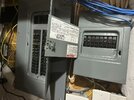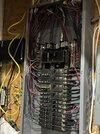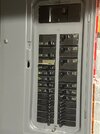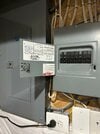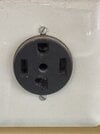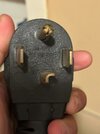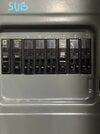I have reached out multiple electricians and received conflicting setups.
I moved into this house last year, so I am not sure what was done prior me moving in.
Most of the electricians told me to go with "no permit" since I already have a subpanel which seems like wasn't done by pulling permit so electricians are telling me that unless I get that panel issue fixes, it would put me in trouble by pulling the EV charger permit and later inspector will visit the site and will find out the sub-panel.
one electrician told me to replace the smaller panel with bigger panel and have 40feet 6/2 romex pulled and use the 60A breaker. This will require me to remove the smaller subpanel and replace with the bigger subpanel. ofcourse huge labor cost + extra sub panel cost involved here.
Other electricians told me to just remove 2 big breakers from the main panel and replace them with the slim breaker and that will give me the space to add a 60A new breaker to put TWC in garage and will use 6/2 romex. its seems to be a cheaper option, but scared since no permit no inspection, I am not sure it will overload the panel or what as first guy stated.
When I discussed this with the first electrician he told me that NO, the main panel is already on it limit utilization ( I think he meant by using the max watts or max amps) so he still pushes to replace the smaller subpanel to larger sub panel.
I more trust on the first electrician who seems to me be more professional but this contradicted info is throwing me off. What's the best way to take care this.
I also have a dryer outlet breaker 6 & 8, is this an easy route to pull another wire from the dryer outlet and have another outlet in my garage to use mobile connector? I am aware that it will cut down my charging speed to half (45a to 32a)
I posted some pictures here for reference and wondering what's the best and cheapest way to get sort this out.
TIA
I moved into this house last year, so I am not sure what was done prior me moving in.
Most of the electricians told me to go with "no permit" since I already have a subpanel which seems like wasn't done by pulling permit so electricians are telling me that unless I get that panel issue fixes, it would put me in trouble by pulling the EV charger permit and later inspector will visit the site and will find out the sub-panel.
one electrician told me to replace the smaller panel with bigger panel and have 40feet 6/2 romex pulled and use the 60A breaker. This will require me to remove the smaller subpanel and replace with the bigger subpanel. ofcourse huge labor cost + extra sub panel cost involved here.
Other electricians told me to just remove 2 big breakers from the main panel and replace them with the slim breaker and that will give me the space to add a 60A new breaker to put TWC in garage and will use 6/2 romex. its seems to be a cheaper option, but scared since no permit no inspection, I am not sure it will overload the panel or what as first guy stated.
When I discussed this with the first electrician he told me that NO, the main panel is already on it limit utilization ( I think he meant by using the max watts or max amps) so he still pushes to replace the smaller subpanel to larger sub panel.
I more trust on the first electrician who seems to me be more professional but this contradicted info is throwing me off. What's the best way to take care this.
I also have a dryer outlet breaker 6 & 8, is this an easy route to pull another wire from the dryer outlet and have another outlet in my garage to use mobile connector? I am aware that it will cut down my charging speed to half (45a to 32a)
I posted some pictures here for reference and wondering what's the best and cheapest way to get sort this out.
TIA



